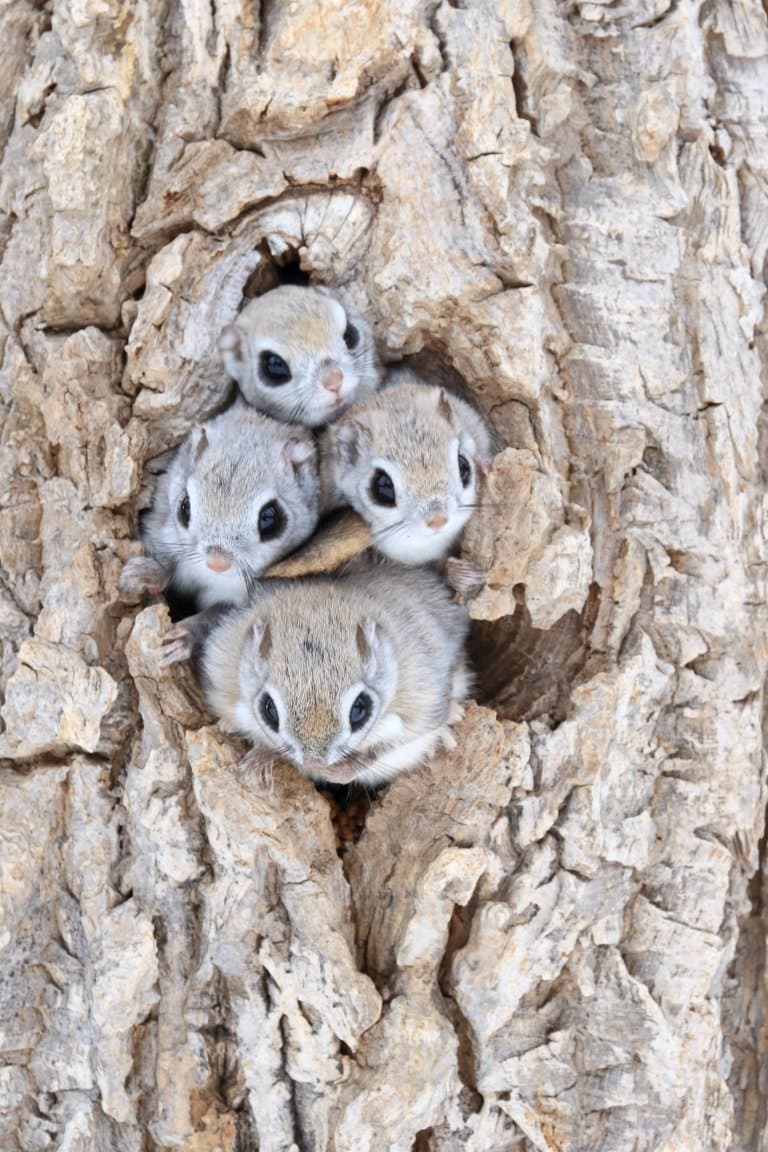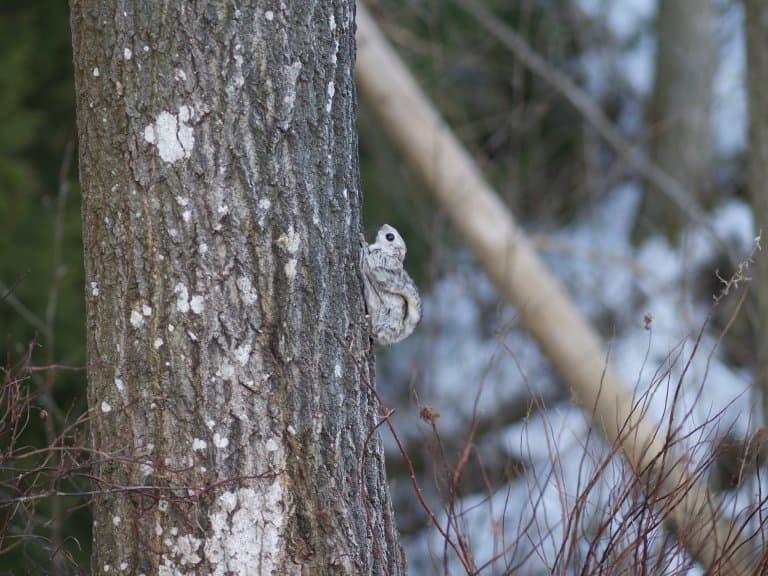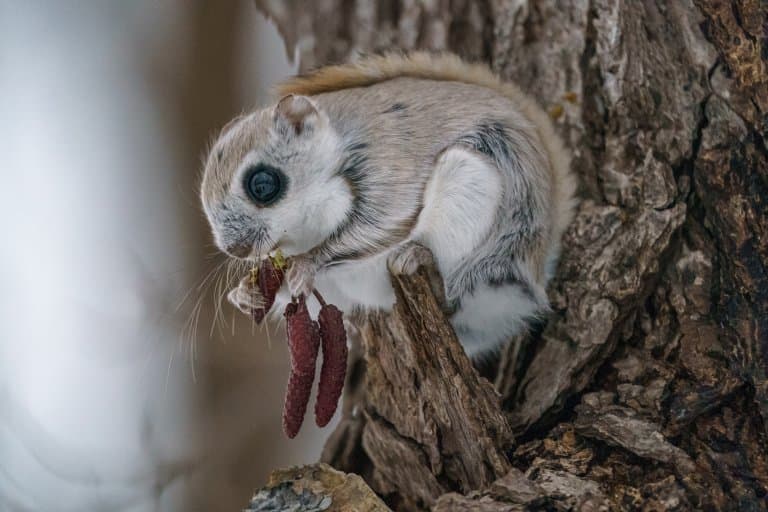Siberian Flying Squirrel Profile
Squirrels are ubiquitous to European forests; marmots and ground squirrels down low and the tree squirrels up in the branches.
But there’s one species up there that’s not well-known; a shy, nocturnal fluff ball with huge eyes and an impressive leap.
Siberian flying squirrels inhabit forests as far West as Finland and as far East as the Pacific Ocean, but their numbers are dwindling.

Siberian Flying Squirrel Facts Overview
| Habitat: | Taiga, deciduous and conifer forest |
| Location: | Eurasia |
| Lifespan: | Around 5 years |
| Size: | Up to 20cm (7.8 inches) |
| Weight: | Around 150g |
| Color: | Grey with white belly |
| Diet: | Leaves, buds, twigs and berries |
| Predators: | Martens, raptors, dogs, cats |
| Top Speed: | 25 kmph (15.6mph) |
| No. of Species: |
1 |
| Conservation Status: |
Least Concern (IUCN), but local populations decreasing |
This super-cute animal inhabits old forests throughout their range, and are mostly nocturnal and active in the evening.
They are rarely seen and will diet on leaves, seeds, nuts and berries and can store food for winter in old woodpecker holes or nooks in trees.
While not quite pilots, flying squirrels are agile, aerial experts, able to leap tens of meters from one tree to the next.
This distance is important to understanding how to protect them as selective logging and habitat destruction threaten local populations.
They’re meticulous about their furniture, well-adapted to the frigid Winters of Eurasia, and grow up fast.
Interesting Siberian Flying Squirrel Facts
1. “Flying” might be a bit of an exaggeration
But they are impressive aerial acrobats!
While not technically capable of powered flight, they are very good at gliding. The major difference is that they can’t go up. Bats are the only mammals capable of true flight, as they can flap and have real wings.
Flying squirrels have skin flaps that act as a parachute, slowing their descent and allowing them to angle their falls during a glide.
Still, they have a glide ratio of over 3:1, which means for every meter they fall, they move 3 meters forward.
To initiate the glide, they spring with their back legs, stretching out their fore and hind limbs to open their gliding membrane.
Their furry, flat tails act as a rudder, giving them the ability to steer, and they’re generally more manoeuvrable than other gliders as a result.
To slow down and land, they orient themselves almost vertically, slowing their fall and grabbing hold of a tree trunk with clawed feet.
This gliding ability doesn’t seem to be affected by weight or sex, and both males and females of all sizes can glide up to almost 50 meters, though the average distance is closer to 20. While they can hit glide ratios of 3:1, around 1:1 is more common, and while it may not seem important, this information could save their species.
2. This has implications for its conservation
Researchers suggest that to retain the flying squirrel populations in any given area, forest gaps should not exceed the distance traversable with a glide ratio of 1:1.
So, forests need to be managed with this in mind if they are taking flying squirrel conservation into account. And this is an issue because, in their native habitats, selective logging often creates gaps in the woodland that squirrels can’t traverse.
The type of tree that’s taken from forests matters, too, as these animals are quite picky about where they call home. 1
3. They like woodpecker holes
Another important feature of this tiny jumper is its preference for hollow trees and woodpecker holes. Flying squirrels occupy holes made by large woodpecker species, that create hollows with holes too small for martens and other squirrel-eaters to enter.
Entrance diameters can be as small as 2cm across, and as long as the adult can get in and out, the smaller, the better!
Each squirrel has a selection of these hollows to choose from, and it stays in a different one depending on the season or its reproductive state. They like to choose hollow trees that are situated behind a couple of big firs, which they use as coverage to hide their entrances. 2

4. They use forest materials to furnish these hollows
Inside a flying squirrel’s hollow is a well-furnished room with a moss pavement and a nest of feathers, animal fluff, and other woodland materials.
One of their favourite building materials is a wispy lichen – a mass made of fibres of fungus and algae – that they gather from nearby trees.
When hollow trees are hard to come by, they’ve been known to furnish bird boxes and other artificial homes.
5. They can handle the cold
Unlike many species of squirrel, these winter warriors don’t hibernate. On days of particularly extreme weather, they may bunker down in their hollows for a while, but as soon as they’re able, they’ll be back out to forage.
Especially during white night periods, these squirrels will be out most of the night, returning just a couple of hours before dawn. They’re so well adapted to the cold that females can successfully rear young throughout this period, despite temperatures dropping lower than 30 degrees Celcius.

6. Babies learn fast
In such an unforgiving world, it pays to pick things up quickly, and flying squirrel babies are very fast learners.
By the time they’re two months old, they look just like their parents, and even before that they are confident enough to glide from tree to tree. Kittens have been seen taking their first leap of faith as early as 40 days, making glides of up to 20 meters.
By the time they’re 50 days old, they’re already competent gliders and independently exploring their forage areas.
7. Habitat fragmentation remains a primary concern for populations everywhere
Because of the nature of their movements, habitat fragmentation affects flying squirrels significantly. While the global population is great enough to ensure the species’ survival (for now), local populations in many countries are dropping fast.
Habitat loss is a big player too, but even within viable habitats, the squirrels need to be able to move from tree to tree to find one another to breed, and this is where they struggle.
Recent surveys are showing declines in areas where their numbers were previously high, and these can be directly attributed to the fragmentation and destruction of old-growth forests. 3

Siberian Flying Squirrel Fact-File Summary
Scientific Classification
| Kingdom: | Animalia |
| Phylum: | Chordata |
| Class: | Mammalia |
| Order: | Rodentia |
| Family: | Sciuridae |
| Genus: | Pteromys |
| Species: | Pteromys Volans |
Fact Sources & References
- Anna E. Airapetyants (2003), “Biology of European flying squirrel Pteromys volans L.”, Russian J. Thierriot.
- Yushin Asari, Hisashi Yanagawa, Tatsuo Oshida (2017), “Gliding ability of the Siberian flying squirrel Pteromys volans orii”, BioOne Digital Library.
- Satu Lampila (2015), “Survival and population growth rate of the threatened Siberian flying squirrel (Pteromys volans) in a fragmented forest landscape”, Taylor & Francis Online.
